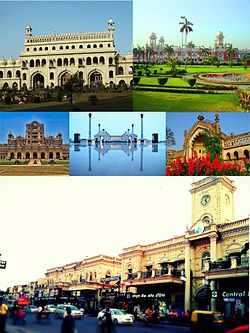Lucknow, Uttar Pradesh
| Lucknow | |
|---|---|

Clockwise from top: Bada Imambara, Charbagh Railway Station, Rumi Darwaza, Hazratganj, La Martiniere School, Ambedkar Memorial Park
|
|
| Nickname(s): The City of Nawabs, The Golden City of India, Constantinople of the East, Shiraz-e-Hind | |
| Location of Lucknow in Uttar Pradesh | |
| Coordinates: 26°48′N 80°54′E / 26.8°N 80.9°ECoordinates: 26°48′N 80°54′E / 26.8°N 80.9°E | |
| Country | India |
| State | Uttar Pradesh |
| Division | Lucknow |
| District | Lucknow |
| Government | |
| • Type | Municipal Corporation |
| • Body | Lucknow Municipal Corporation |
| • MP | Rajnath Singh (BJP) |
| • Commissioner, Lucknow Division | Anil Garg, IAS |
| • District Magistrate and Collector | Kaushal Raj Sharma, IAS |
| • Inspector General, Lucknow Range | Ajay Narain Singh, IPS |
| • Senior Superintendent of Police | Deepak Kumar, IPS |
| Elevation | 123 m (404 ft) |
| Population (2011) | |
| • Metropolis | 2,817,105 |
| • Rank | 11th |
| • Metro | 2,902,920 |
| • Metro Rank | 12th |
| Demonym(s) | Lakhnawi, Lucknowite |
| Time zone | IST (UTC+5:30) |
| PIN | 2260xx / 2270xx |
| Telephone code | +91-522 |
| Vehicle registration | UP 32 |
| GDP | $22 billion |
| Sex ratio | 915 ♀/1000 ♂ |
| Languages | Hindi, Urdu, English |
| Website | Official website |
| Population growth | |||
|---|---|---|---|
| Census | Pop. | %± | |
| 1871 | 284,800 |
—
|
|
| 1881 | 261,300 | -8.3% | |
| 1891 | 273,000 | 4.5% | |
| 1901 | 264,000 | -3.3% | |
| 1911 | 259,800 | -1.6% | |
| 1921 | 240,600 | -7.4% | |
| 1931 | 274,700 | 14.2% | |
| 1941 | 387,177 | 40.9% | |
| 1951 | 496,900 | 28.3% | |
| 1961 | 595,400 | 19.8% | |
| 1971 | 814,000 | 36.7% | |
| 1981 | 1,007,604 | 23.8% | |
| 1991 | 1,669,204 | 65.7% | |
| 2001 | 2,245,509 | 34.5% | |
| 2011 | 2,902,601 | 29.3% | |
| source: | |||
Lucknow(/ˈlʌknaʊ/ Lakhna'ū) is the capital of the Indian state of Uttar Pradesh and is also the administrative headquarters of the eponymous District and Division. It is the largest city in Uttar Pradesh,the eleventh most populous city and the twelfth most populous urban agglomeration of India. Lucknow has always been known as a multicultural city that flourished as a North Indian cultural and artistic hub, and the seat of power of Nawabs in the 18th and 19th centuries. It continues to be an important centre of governance, administration, education, commerce, aerospace, finance, pharmaceuticals, technology, design, culture, tourism, music and poetry.
The city stands at an elevation of approximately 123 metres (404 ft) above sea level. Lucknow district covers an area of 2,528 square kilometres (976 sq mi). Bounded on the east by Barabanki, on the west by Unnao, on the south by Raebareli and in the north by Sitapur and Hardoi, Lucknow sits on the northwestern shore of the Gomti River. Hindi is the main language of the city and Urdu is also widely spoken. Lucknow is the centre of Shia Islam in India with the highest Shia Muslim population in India.
...
Wikipedia


